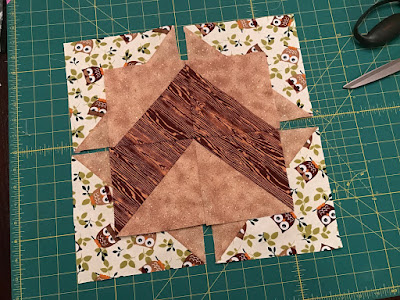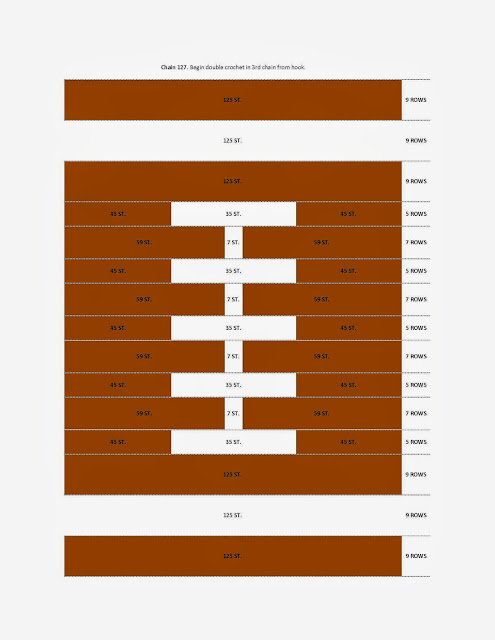Half Square Triangle Cheat Sheet
Oh boy! I always hated math when I was in school... I just didn't get it. But you know what? I use geometry and algebra WAY MORE than I ever thought I would for my job as an art director/concept designer, and even for quilting!
And I actually kind of enjoy it.
So here's my latest predicament: I wanted to make a whole bunch of half square triangles to piece together and blend into a quilt with 9.5" squares.
Obviously, I wanted to save some time doing it, so I opted for the "four at once" method, in which you sew two squares face to face all the way around the outer edges, then cut them apart with an X across the middle. But... what the heck size squares do I start with if I want them to be 9.5" when they're done?
I originally assumed that, well, if I'm cutting the blocks apart, they're getting smaller in size, right? I don't remember what I did to get this number, but for some reason I wrote down on a sticky note that I needed 10.75" squares. I got home from work and tried it with some scrap material... and... umm... nope. That's not right. Each one of my HST squares was 7", which would give me a 13.5" square. They actually get bigger!
And then I sat down and thought it through. Essentially, we're creating four squares that have point to point dimensions that are double that of side dimensions of the original squares (minus 1/4" seam allowance). This is going to require some trigonometry! The Pythagorean Theorem, to be exact. You know... A squared plus B squared equals C squared and all that jazz. If I've lost you, just skip ahead to the chart at the end of the post- no mathing required! :)
Let's look at a diagram or three. That will be helpful.
In this diagram, we started with an eight and a half inch square. The seam allowance and cut lines are marked as well, and we'll be taking a closer look at the blue triangle.
The original hypotenuse of the blue triangle is the width of your start squares minus seam allowance; in this case, eight inches. But, in order to figure out the size of the square that will be created when two of these triangles are combined, we need to figure out the length of the other legs of the triangle.
I divided my triangle in half down the middle, creating a new isosceles right triangle. Remember- the Pythagorean Theorem only works on right triangles; ones with a 90 degree angle. I knew that since the short leg on the bottom was half of eight (four), that the other short leg must also be four (the definition of an isosceles triangle- two sides of equal length). I needed to find C, the hypotenuse.
This is the size of one of the HST blocks. But there will be four! Multiply the width (or height, I guess, you pick!) of the small square by two, and subtract half an inch for seam allowance.
2(5.5)-.5= approximately 10.5" Finished Size (after trimming HST blocks).
I attempted to make some fancy formula to figure this all out in one shot... but it failed miserably. Real math people, I apologize! The best I could do to really crunch the numbers efficiently was this:
Clearly, you need to find C first to use it in the equation, but that's easy when you think about it as a quilt block, right?
And, for those of you who'd rather not know the ins and outs of why things are the way they are, a handy reference chart! Find the finished size you want on the right and cut fabric to the sizes indicated in the left column. These are the closest start sizes for the indicated finished sizes; many require a slight trim to be exact (the center column)- always trim your HST blocks BEFORE assembling all four (or your points will be off). If you need a size in between, cut for the next size up and trim down.
Happy Half Square Triangle making!
And I actually kind of enjoy it.
So here's my latest predicament: I wanted to make a whole bunch of half square triangles to piece together and blend into a quilt with 9.5" squares.
Obviously, I wanted to save some time doing it, so I opted for the "four at once" method, in which you sew two squares face to face all the way around the outer edges, then cut them apart with an X across the middle. But... what the heck size squares do I start with if I want them to be 9.5" when they're done?
I originally assumed that, well, if I'm cutting the blocks apart, they're getting smaller in size, right? I don't remember what I did to get this number, but for some reason I wrote down on a sticky note that I needed 10.75" squares. I got home from work and tried it with some scrap material... and... umm... nope. That's not right. Each one of my HST squares was 7", which would give me a 13.5" square. They actually get bigger!
And then I sat down and thought it through. Essentially, we're creating four squares that have point to point dimensions that are double that of side dimensions of the original squares (minus 1/4" seam allowance). This is going to require some trigonometry! The Pythagorean Theorem, to be exact. You know... A squared plus B squared equals C squared and all that jazz. If I've lost you, just skip ahead to the chart at the end of the post- no mathing required! :)
 |
| These formulas did NOT work out. Don't use them. ha ha. |
Let's look at a diagram or three. That will be helpful.
In this diagram, we started with an eight and a half inch square. The seam allowance and cut lines are marked as well, and we'll be taking a closer look at the blue triangle.
The original hypotenuse of the blue triangle is the width of your start squares minus seam allowance; in this case, eight inches. But, in order to figure out the size of the square that will be created when two of these triangles are combined, we need to figure out the length of the other legs of the triangle.
I divided my triangle in half down the middle, creating a new isosceles right triangle. Remember- the Pythagorean Theorem only works on right triangles; ones with a 90 degree angle. I knew that since the short leg on the bottom was half of eight (four), that the other short leg must also be four (the definition of an isosceles triangle- two sides of equal length). I needed to find C, the hypotenuse.
This is the size of one of the HST blocks. But there will be four! Multiply the width (or height, I guess, you pick!) of the small square by two, and subtract half an inch for seam allowance.
2(5.5)-.5= approximately 10.5" Finished Size (after trimming HST blocks).
I attempted to make some fancy formula to figure this all out in one shot... but it failed miserably. Real math people, I apologize! The best I could do to really crunch the numbers efficiently was this:
Clearly, you need to find C first to use it in the equation, but that's easy when you think about it as a quilt block, right?
 |
| Ahh, that's better! |
Happy Half Square Triangle making!











Comments
Post a Comment